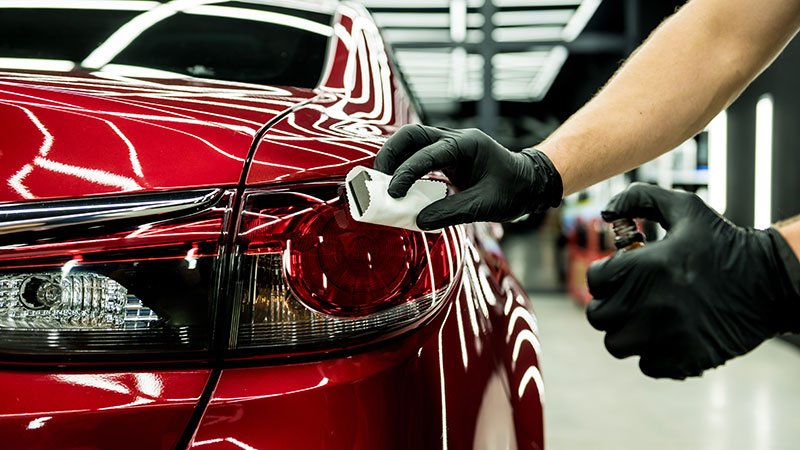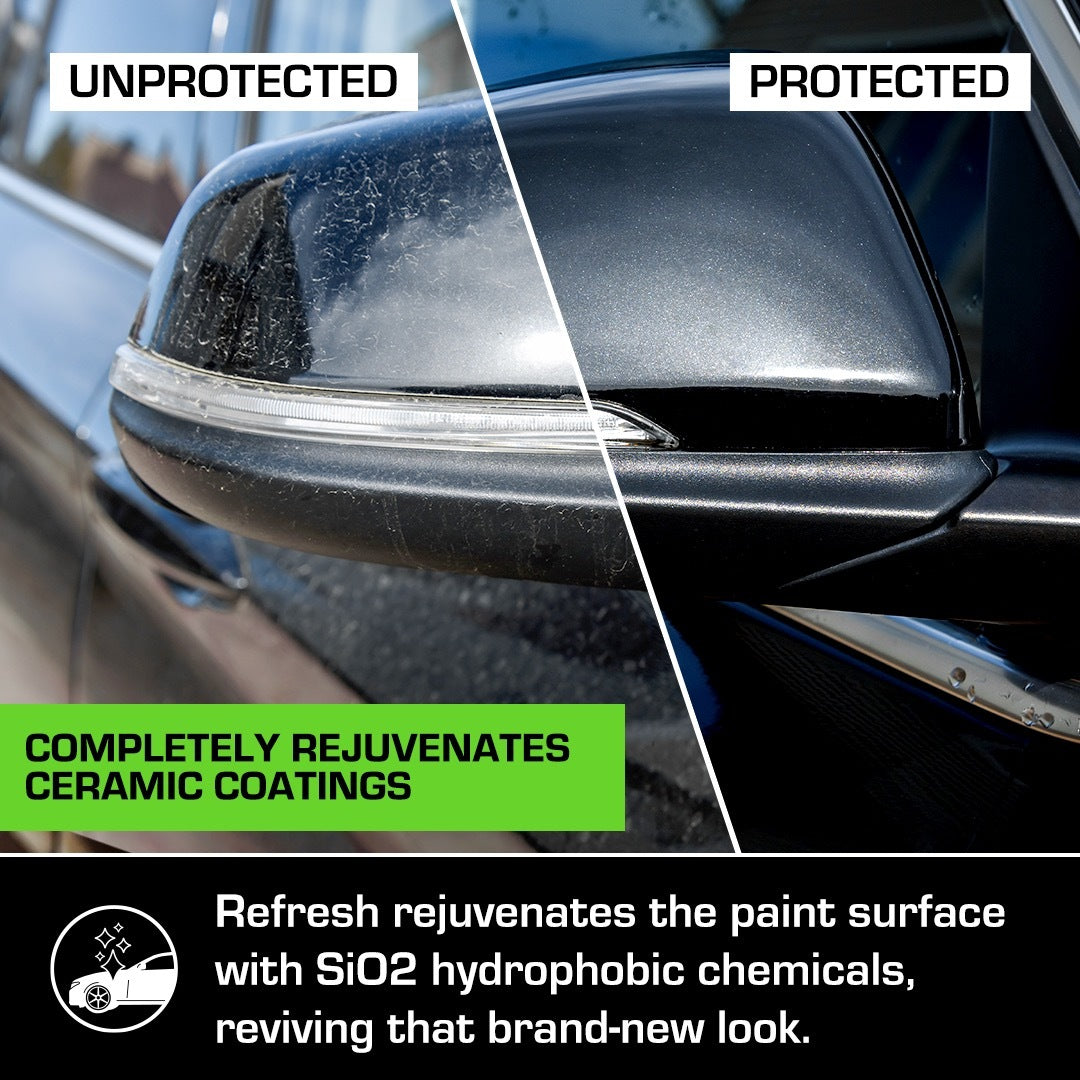Exploring the Scientific Research Behind Car Ceramic Coating and Its Protective Characteristics
The science of car ceramic coating provides a remarkable research study in advanced vehicle protection. Composed mostly of silicon dioxide and polymers, these finishes create a robust bond with vehicle paint. This interaction improves sturdiness versus environmental dangers while supplying hydrophobic benefits. The complexities of how these layers work and their long-term benefits remain less comprehended. Ceramic Coating Newark. Unboxing these information discloses why ceramic coverings are ending up being a favored choice for car care
What Is Ceramic Coating?
Ceramic coating is a fluid polymer that chemically bonds to the surface of a lorry's paint. This innovative protective layer improves resilience and offers exceptional resistance to environmental aspects. Unlike typical wax or sealants, which supply momentary security, ceramic coatings develop a long-lasting guard that can endure rough conditions such as UV rays, acidic pollutants, and extreme weather condition. When applied appropriately, the coating forms a hydrophobic surface area, triggering water to grain and slide off, which aids in maintaining the lorry's tidiness. Furthermore, it uses improved gloss and deepness to the paint, making the vehicle show up more sleek and lively. The application process typically includes thorough surface preparation, including cleaning and sprucing up, to guarantee peak bonding. Because of this, ceramic finishes are coming to be significantly preferred among car enthusiasts and those looking for to secure their financial investments, assuring to keep the vehicle's visual appeal while decreasing the frequency of upkeep.
The Structure of Ceramic Coatings
The intricate formula of ceramic finishings largely consists of silicon dioxide (SiO2), which is acquired from natural resources like quartz and sand. This key part offers the foundation for the coating's longevity and safety high qualities. Along with SiO2, ceramic coatings typically consist of various polymers and additives that boost bond, adaptability, and resistance to environmental aspects. These substances work synergistically to create a durable obstacle versus pollutants such as dust, chemicals, and UV rays.Furthermore, some formulas integrate titanium dioxide (TiO2) or other nanomaterials, which can enhance the coating's hydrophobic residential or commercial properties, leading to better water repellency. The exact structure can vary substantially amongst makers, impacting performance and longevity. Ultimately, the combination of these aspects finishes in a safety layer that not just improves the visual charm of automobiles however likewise serves to extend their lifespan by shielding the surface area from prospective damage.
Just How Ceramic Coatings Job
Recognizing how ceramic finishes function involves exploring their chemical make-up, which adds to their safety top qualities. The application process is crucial for attaining optimal results, while longevity and resilience aspects establish the coating's effectiveness with time. Together, these aspects highlight the benefits and efficiency of ceramic coverings for lorry security.
Chemical Composition Explained
While several car proprietors look for resilient protection for their automobiles, the chemical make-up of ceramic finishes plays a crucial role in their performance. These coverings largely contain silicon dioxide (SiO2), which is originated from natural minerals. This compound creates a strong bond with the automobile's paint, developing a sturdy, protective layer. In addition, many ceramic layers contain titanium dioxide (TiO2), enhancing their hydrophobic residential properties and resistance to UV rays. The presence of polysiloxanes can further boost versatility and longevity. Together, these aspects add to the coating's ability to fend off water, dust, and impurities, while additionally offering a high-gloss surface. Comprehending this chemical structure aids car proprietors appreciate the robust security used by ceramic finishings.
Application Process Introduction
Applying ceramic finishes involves a careful process that assures ideal bonding and security for the vehicle's surface area. Initially, complete cleansing and decontamination of the car's outside are executed to eliminate dust, gunk, and previous waxes. This action confirms that the surface area is without pollutants that could impede attachment. Following this, the paint is usually brightened to improve clearness and get rid of any type of blemishes. Once prepared, the ceramic coating is used in tiny areas making use of an applicator pad, enabling uniform insurance coverage. The coating is then delegated cure, forming a strong chemical bond with the surface area. Correct healing times and problems are essential, as they confirm the coating accomplishes its optimum efficiency and protective top qualities.
Long Life and Toughness Aspects
Ceramic coatings are designed to give resilient protection via their advanced chemical make-up, which creates a robust barrier versus ecological impurities. The toughness of these finishes is affected by variables such as the density of the application, the quality of the product, and the conditions under which the automobile is exposed. Top quality ceramic layers can last numerous years, resisting scrapes, UV rays, and chemical spots. Proper upkeep, consisting of regular washing and regular reapplication, can further improve long life. In addition, environmental variables like environment and exposure to toxins can impact the lifespan of the coating. On the whole, when applied and preserved correctly, ceramic coverings offer remarkable toughness, making them a popular other selection for car weblink enthusiasts seeking to maintain their vehicle's appearance.
Hydrophobic Properties and Water Repellency
Hydrophobic buildings are a hallmark of quality car ceramic coatings, significantly enhancing the automobile's surface performance. These layers develop a molecular bond with the car's paint, leading to a surface area that pushes back water properly. When water enters contact with a ceramic-coated surface area, it beads up and rolls off, reducing the amount of fluid that remains on the paint. This habits not only adds to a cosmetically pleasing appearance yet also lowers the build-up of pollutants such as dirt, gunk, and road salts.The boosted water repellency brings about easier cleaning and upkeep, as much less effort is required to remove unwanted materials. Additionally, the hydrophobic nature of ceramic layers helps in protecting against water places, which can mar the finish of uncoated surfaces. In general, the incorporation of hydrophobic residential properties in ceramic finishes plays an essential role in maintaining the car's pristine appearance while simplifying upkeep.
Defense Against Scratches and UV Damage
Car ceramic coatings use substantial defense versus scrapes and UV damage. The scratch resistance system creates a durable layer that takes in influences, while the UV protecting advantages assist preserve the vehicle's paint integrity with time. Together, these functions add to a longer-lasting and aesthetically enticing surface.
Scratch Resistance System
Utilizing advanced modern technology, ceramic coatings supply a robust shield against scratches and UV damages, enhancing the long life and appearance of vehicle surface areas. The scratch resistance system of these coatings is associated to their one-of-a-kind molecular structure, which develops a durable bond with the lorry's paint. This bond produces a hard, protective layer that can soak up impacts and resist abrasions. In addition, the smooth surface of the coating lowers rubbing, making it hard for impurities to stick and cause scratches. The chemical structure of ceramic coatings typically consists of nanoparticles that strengthen the safety layer, more enhancing its durability. Cars treated with ceramic finishes show considerably boosted scratch resistance contrasted to traditional wax or sealers, making certain a pristine surface over time.
UV Protecting Benefits
The safety qualities of ceramic finishings prolong past scrape resistance to consist of substantial UV shielding advantages. These finishes develop a durable barrier that mirrors damaging ultraviolet rays, safeguarding the car's paint and underlying products. Extended exposure to UV radiation can result in fading, oxidation, and damage of the paint surface. By including ceramic coverings, car proprietors can successfully mitigate these risks, preserving the visual charm and honesty of their automobiles. In addition, the UV blocking residential properties add to boosted longevity, reducing the regularity of painting and upkeep. Eventually, the assimilation of ceramic layers supplies a complete solution for safeguarding vehicles from the destructive effects of sunlight direct exposure, ensuring a continual, dynamic appearance with time.
The Longevity and Maintenance of Ceramic Coatings

Regularly Asked Questions
Can Porcelain Coating Be Applied to Any Kind of Car?
Ceramic coating can be related to various sorts of vehicles, consisting of cars and trucks, trucks, and motorcycles. Surface prep work and compatibility with specific materials are vital for optimal attachment and efficiency of the coating.
Just How Much Does Ceramic Coating Generally Cost?
Ceramic coating usually sets you back between $500 and $2,000, relying on aspects such as vehicle dimension, coating high quality, and professional application. The financial investment can supply lasting protection and boost the vehicle's appearance with time.

Is Expert Application Needed for Ideal Outcomes?
The requirement of professional application typically depends on desired outcomes. Specialists normally assure appropriate surface preparation and application methods, resulting in suitable bonding official website and durability of the coating, which may be challenging for unskilled individuals to attain.
Can Ceramic Coatings Be Eliminated or Repaired?
Ceramic coatings can be eliminated or fixed, though the process may need details solvents or methods - Ceramic Coating Newark. Appropriate removal is vital to prevent damage to the underlying surface area, stressing the value of expert support for optimal results
Just How Does Porcelain Coating Contrast to Traditional Wax?
The contrast between ceramic coating and conventional wax discloses that ceramic coatings provide remarkable durability, boosted security versus ecological impurities, and longer-lasting shine, while wax requires more constant application and provides less general resistance to damage.